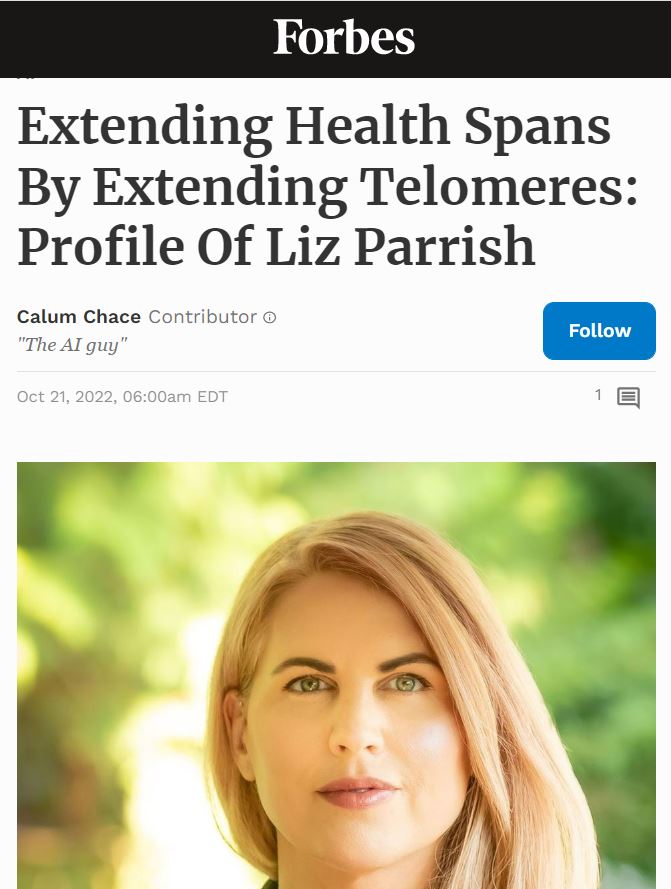Patient zero
Liz Parrish was nervous. She was on a plane to Colombia, where she would undergo an untested gene therapy. She and her colleagues had spent two years developing the therapy and making the preparations, but they could not know how it would work out.
It was September 2015, and Parrish had been inspired to take this step because her son, suffering from type 1 diabetes, was unable to obtain treatment for his condition in the USA. She decided to embark upon a mission to persuade the FDA to move from a precautionary approach to a proactive one. It is a mission she is still pursuing today.
Startling results
The treatment consisted of two intravenous injections, and it passed without incident. There followed a wait of several weeks for the results. The report was startling. Before the treatment, the biomarkers used by Parrish indicated that her biological age was 66, a full 22 years more than her chronological age. (Your biological age describes the condition of your body relative to your peers; your chronological age is simply the number of journeys you have made around the sun). After the treatment, her reported biological age fell to match her actual age.
Parrish repeated the treatment in 2020, and she reports that since 2015, her biological age has declined by an average of five years every year. It dropped sharply again after the second treatment, and is now, remarkably, below 25.
Controversy
Parrish makes this data publicly available, but her approach has proved controversial. George Martin, a professor of pathology at the University of Washington, was an adviser to Parrish’s firm BioViva, but resigned when he heard about the trip to Colombia. Maria Blasco, the Spanish scientist whose pioneering work underpins Parrish’s treatment insists that no therapies should be deployed without rigorous trials validated by the FDA and other regulatory agencies.
Parrish is unrepentant. She does not dispute the need to make medicinal practice as safe as possible, but points out that it can never be wholly risk-free. “People are killed by regulated drugs all the time.” The type of therapy she took had been achieving extraordinary results in mice for over a decade. Mice and humans are of course very different species, but the therapy had also been shown not to harm human cells. Parrish cites a World Health Organisation figure: “41 million people are dying right now of aging associated, non-communicable diseases. We could save them. We need to get on the right side of history.”
In the years since her treatment, Parrish has met presidents, health ministers, and policy makers around the world. There is plenty of interest in her arguments, but there is also fear of stepping out of line. Parrish hopes that one way this resistance may be overcome is by making new therapies available to end-of-life patients without the usual testing – patients who have tried every approved approach and have no remaining alternative.
Medical tourism
It takes decades and billions of dollars to bring a new drug to market, which means that many promising therapies are never given a chance. (There are promising signs that AI may help to slash these times and costs.) One upshot of this is the rise of medical tourism, with patients travelling to clinics outside the jurisdiction of the FDA and similar agencies. Many of these clinics are reputable, professionally-run institutions, but others not so much. Parrish argues that the existence of medical tourism is a sign that something is wrong in the medical establishment, and she also notes that 80% of the medical trials conducted by large pharmaceutical companies are carried out offshore.
There is no way of knowing how many people have followed in Parrish’s footsteps, but she thinks there are many. Given the remarkable results that she reports, it is perhaps surprising that there have not been more.
Telomeres
The main gene therapy treatment Parrish underwent was designed to extend her telomeres. (She also took a myostatin inhibitor which combats muscle loss.) Our genes consist of entwined strings of DNA molecules called chromosomes. When our cells divide, these strings would become frayed if it were not for the protection afforded by telomeres. Telomeres are sections of DNA which repeat information, and are hence expendable. When a cell divides more than a certain amount (the so-called Hayflick limit, which is usually 50 to 70 times), the telomeres effectively run out, and the chromosome itself is damaged. A substance called telomerase can prevent this decay, and preserve the genetic stability of the cell.
Parrish’s reduced biological age is measured by the number of telomeres in her white blood cells – specifically, in her T-lymphocytes, a type of white blood cell which plays an important role in the body’s immune response.
Gene therapy is delivered using viruses, known as “vectors”. The therapy Parrish used in 2015 used a vector called AAV, and her company is now working on another vector called cytomegalovirus (CMV). Both technologies occur naturally in humans and monkeys, and both can deliver genes that produce telomerase without altering the genetic makeup of the chromosome. But CMV can deliver larger genetic payloads than AAV, and BioViva is now designing therapies that use multiple genes to control the aging process. BioViva has been working with Rutgers University to improve this technology, and holds some patents as a result.
Parrish does not believe that telomere lengthening is the be-all-and-end-all of fighting aging. There are long-lived species whose telomeres shorten quickly, and vice versa. Human biology is confoundingly complex, and aging will not be defeated by a single silver bullet. But she is confident that telomere lengthening has a significant role to play in the fight.
Exciting future
Parrish is an enthusiast and an optimist. If governments do not find a way to speed up the adoption of new healthcare techniques, she worries that a health divide will develop, in which people who can afford the fees and travel costs involved in medical tourism will enjoy significantly better health outcomes than those who cannot. But if governments do step up the challenge, she foresees a future – only a decade or two in the future – in which people enjoy healthier old age, and then start to extend their lifespans. She exhorts us all to “be excited about the future!”



